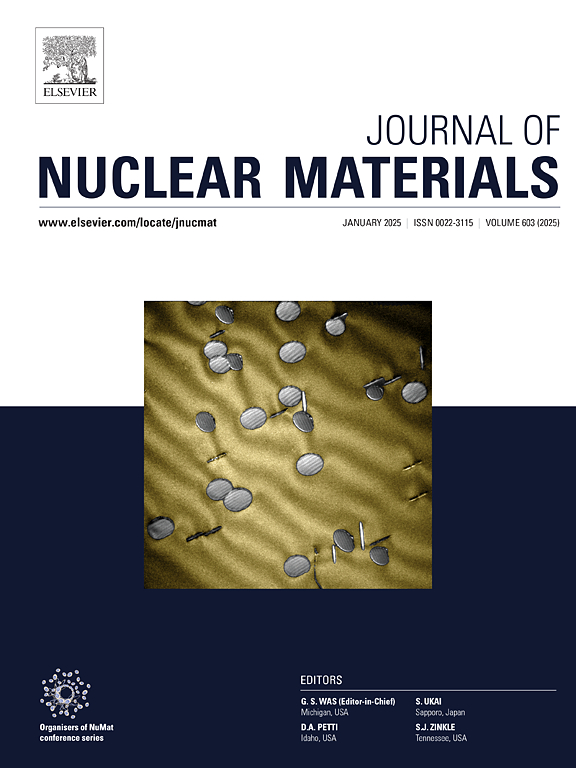The impact of chromium coatings on Zircaloy cladding deformation behavior under reactivity-initiated accident-like mechanical loading conditions
IF 2.8
2区 工程技术
Q3 MATERIALS SCIENCE, MULTIDISCIPLINARY
引用次数: 0
Abstract
A reactivity-initiated accident (RIA) occurs when a control rod ejection or control blade drop causes an increase in the fission rate. The injection of energy results in an increase in fuel temperature which in turn causes rapid thermal expansion of the fuel pellet. This thermal expansion may result in pellet-cladding mechanical interaction (PCMI) in which the fuel imparts a mechanical strain to the cladding. PCMI may cause the cladding to fail, and thus, the mechanical response of cladding due to PCMI must be investigated when characterizing new cladding materials. Chromium-coated Zircaloy-4 is a near-term accident-tolerant fuel cladding that exhibits improved high-temperature oxidation resistance. Modified burst testing was utilized to experimentally simulate the effects of PCMI on both uncoated and chromium-coated Zircaloy cladding samples at hot zero power conditions. Samples were coated using either cold spraying or physical vapor deposition to understand the differences in behavior that the coating application method may cause. Digital image correlation was used to analyze images of the deforming specimens to extract the in-situ strain behavior of the cladding. The uncoated specimens burst at hoop strains ranging from 8.8 % to 17.2 %. The cold-spray chromium-coated Zircaloy specimens burst at hoop strains of 7.0 % to 11.0 %. The physical vapor deposition coated tubes burst at hoop strains of 9.1 % to 11.5 %. These results indicate that the chromium coating causes a loss in the ductility of the cladding. The higher burst hoop strains of the physical vapor deposition-coated samples relative to the cold-spray samples indicate that the cold-spraying technique causes more of a loss in ductility than physical vapor deposition. All samples burst at higher hoop strains than those expected to occur in an RIA for fresh cladding.
在反应性引发的类似事故的机械加载条件下,铬涂层对锆合金包层变形行为的影响
当控制棒弹射或控制叶片下降导致裂变速率增加时,就会发生反应性引发的事故。能量的注入导致燃料温度的升高,这反过来又导致燃料颗粒的快速热膨胀。这种热膨胀可能导致颗粒-包壳机械相互作用(PCMI),其中燃料向包壳施加机械应变。PCMI可能导致包层失效,因此,在表征新包层材料时,必须研究PCMI引起的包层力学响应。镀铬锆合金-4是一种近期耐事故的燃料包层,具有更好的高温抗氧化性能。采用改进的爆炸试验方法,模拟了PCMI在热零功率条件下对未包覆和包覆铬锆合金样品的影响。采用冷喷涂或物理气相沉积对样品进行涂层处理,以了解涂层应用方法可能导致的行为差异。采用数字图像相关技术对变形试样图像进行分析,提取熔覆层的原位应变行为。未包覆的试样在8.8% ~ 17.2%的环应变范围内破裂。冷喷涂镀铬锆合金试样在环向应变为7.0% ~ 11.0%时发生破裂。物理气相沉积涂层管在环向应变为9.1% ~ 11.5%时破裂。这些结果表明,铬涂层导致熔覆层的延展性损失。与冷喷涂相比,物理气相沉积涂层样品的破裂环应变更高,这表明冷喷涂技术比物理气相沉积技术造成的延性损失更大。所有样品在更高的环向应变下爆裂,而这些环向应变比在新包层的RIA中预期发生的要高。
本文章由计算机程序翻译,如有差异,请以英文原文为准。
求助全文
约1分钟内获得全文
求助全文
来源期刊

Journal of Nuclear Materials
工程技术-材料科学:综合
CiteScore
5.70
自引率
25.80%
发文量
601
审稿时长
63 days
期刊介绍:
The Journal of Nuclear Materials publishes high quality papers in materials research for nuclear applications, primarily fission reactors, fusion reactors, and similar environments including radiation areas of charged particle accelerators. Both original research and critical review papers covering experimental, theoretical, and computational aspects of either fundamental or applied nature are welcome.
The breadth of the field is such that a wide range of processes and properties in the field of materials science and engineering is of interest to the readership, spanning atom-scale processes, microstructures, thermodynamics, mechanical properties, physical properties, and corrosion, for example.
Topics covered by JNM
Fission reactor materials, including fuels, cladding, core structures, pressure vessels, coolant interactions with materials, moderator and control components, fission product behavior.
Materials aspects of the entire fuel cycle.
Materials aspects of the actinides and their compounds.
Performance of nuclear waste materials; materials aspects of the immobilization of wastes.
Fusion reactor materials, including first walls, blankets, insulators and magnets.
Neutron and charged particle radiation effects in materials, including defects, transmutations, microstructures, phase changes and macroscopic properties.
Interaction of plasmas, ion beams, electron beams and electromagnetic radiation with materials relevant to nuclear systems.
 求助内容:
求助内容: 应助结果提醒方式:
应助结果提醒方式:


